Migraines
Back Clinic Migraine Team. This is a genetic neurological disease characterized by episodes called Migraine attacks. They are quite different from regular headaches, which are non-migrainous. About 100 million people suffer from headaches in the U.S., And 37 million of these people suffer migraines. The World Health Organization estimates that 18 percent of women and 7 percent of men in the U.S. suffer.
They are called primary headaches because the pain is not caused by a disorder or disease, i.e., a brain tumor or head injury. Some cause pain only on the right side or left side of the head. In contrast, others result in pain everywhere. Individuals that suffer can have moderate or severe pain but usually can’t participate in regular activities because of the pain.
When a migraine strikes, a quiet, dark room may help with the symptoms. Migraines can last for four hours or can last for days. The range of time someone is affected by an attack is actually longer than the migraine itself. This is because a pre-monitory or build-up and a post-drome can last for one to two days.

by Dr Alex Jimenez DC, APRN, FNP-BC, CFMP, IFMCP | Chiropractic, Migraines, Neck Pain, Wellness
El Paso, TX. Chiropractor Dr. Alex Jimenez looks at stretches for neck pain.
Your neck is one of the hardest working parts of your body.�It is serves us well as a source of strength and balance. When it�s out of whack, your neck can be a source of unending distress. �Let�s face it�today�s use of technology has our necks being put to use in ways it was never intended. �Did you know that looking down at your phone can sometimes exert as much pressure as the equivalent of a 40lb weight?
Unfortunately for the vast majority of people, neck pain will affect them at some point in their lives. Women are more prone to neck pain but men definitely have their fair share as well.
One Of The Reasons Our Necks Pay A Price… We Sit A Lot
Whether it is at home in front of the TV or electronics or at work in front of the computer, our necks get a work out! Distresses on the neck are felt in many ways, including but not limited to: low back pain, severe headache, migraines, or even facial aching and tenderness.
What are some of the gentle ways you can give your neck a break? Good question, we are glad you asked! Thankfully, stretching our neck muscles regularly is easy to do and it can help relieve and prevent neck pain.
Read more: http://paininjuryrelief.com/get-ahead-of-your-neck-pain/#ixzz4Q3iGAMqs
The Graphic Below Shows Some Easy Stretches To Help:
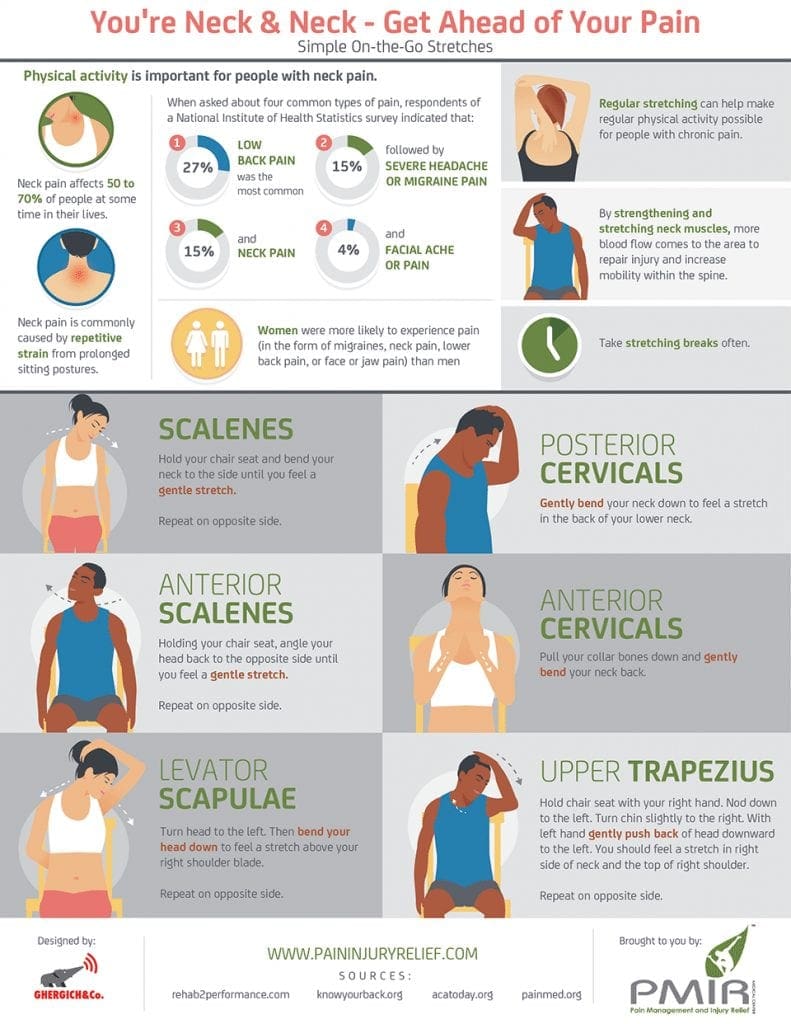

Call Today!
Source:
PMIR
Comments
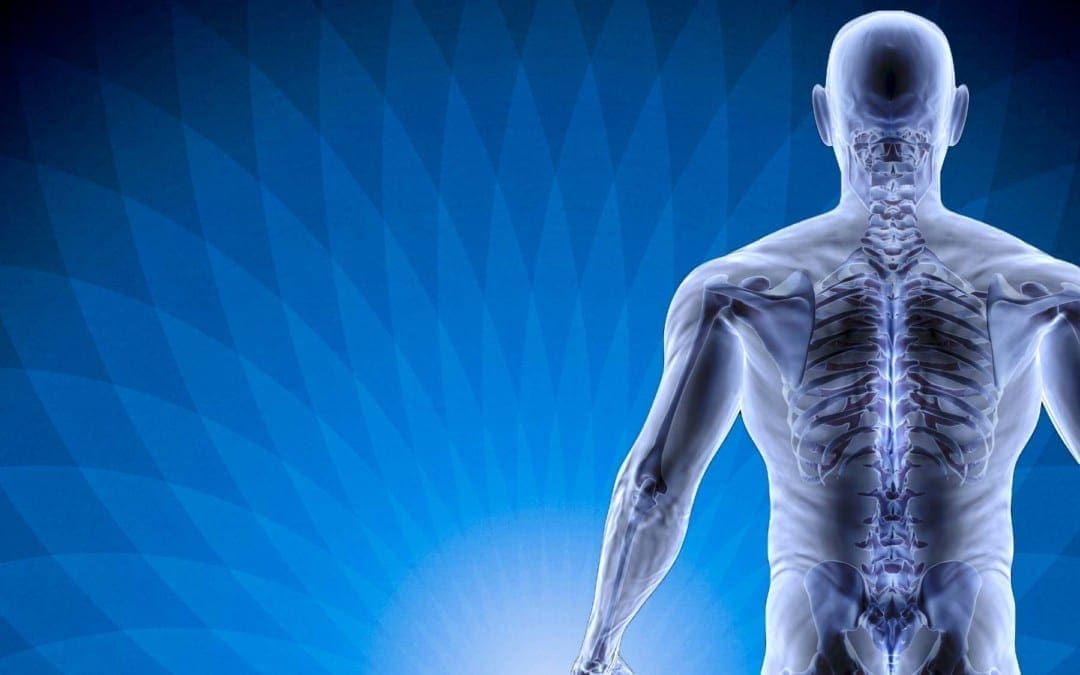
by Dr Alex Jimenez DC, APRN, FNP-BC, CFMP, IFMCP | Chiropractic, Chronic Back Pain, Migraines, Neck Pain
El Paso, TX. Chiropractor Dr. Alex Jimenez investigates pain, the spine and its connection to internal organs.
Right after I had my first son, I suffered from headaches and some digestive issues. I had never had digestive issues before, but I passed it off as a side effect of giving birth to a living being. I also blamed the pressures of being in school and raising a small child.
My husband went to a chiropractor to treat some pain in his hands, and that is when I decided to try it as well. The chiropractor re-aligned my spine and, with weekly visits, I was feeling much better.
When my family and I moved to South Korea, I could not find a chiropractor. I did, however, find an excellent acupuncturist that had his office two blocks away from my front door. Instead of working on my spine, the acupuncturist worked on the muscles around my spine.
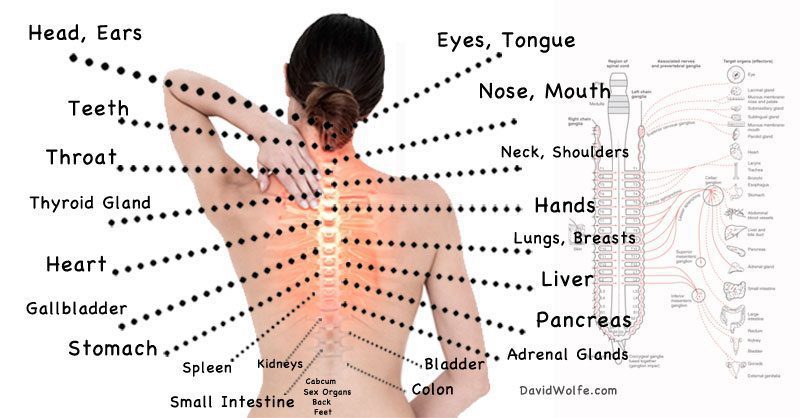
I feel the results of both were the same. I always felt much better when I took the time to take care of my spine and nervous system.
This is because all our organs receive messages from our brain via our spinal cord. The lungs know to breath in and out because of the messages they receive from the brain. The heart beats because of these messages as well. Every organ in our body is connected to the brain and blocking this connection�even a little�can cause serious health issues.
Some health problems are easily felt like numbness in the fingers or a headache. Some troubles are not so apparent like digestive issues or kidney problems. If the spine is out of order, the organs will feel it.
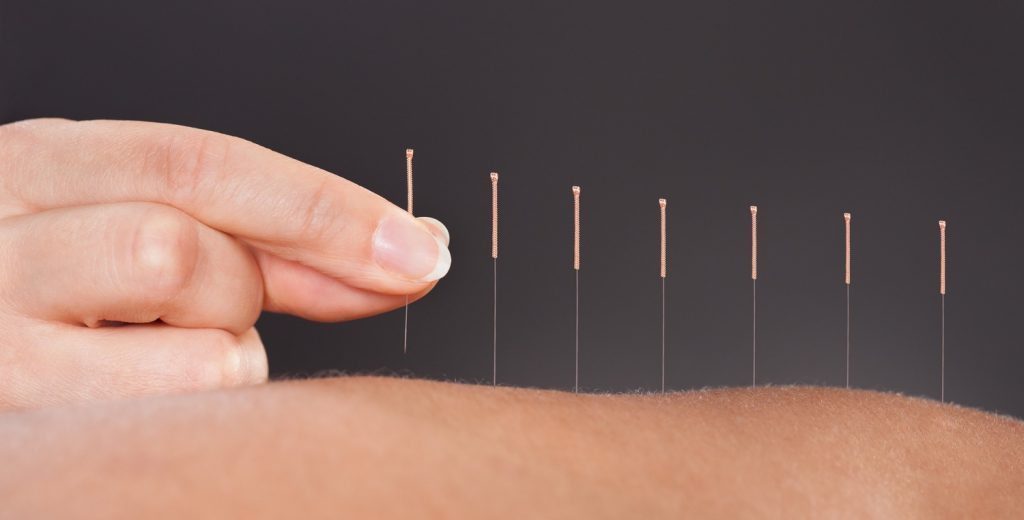
It Is Important To Take Care Of The Spine Every Day
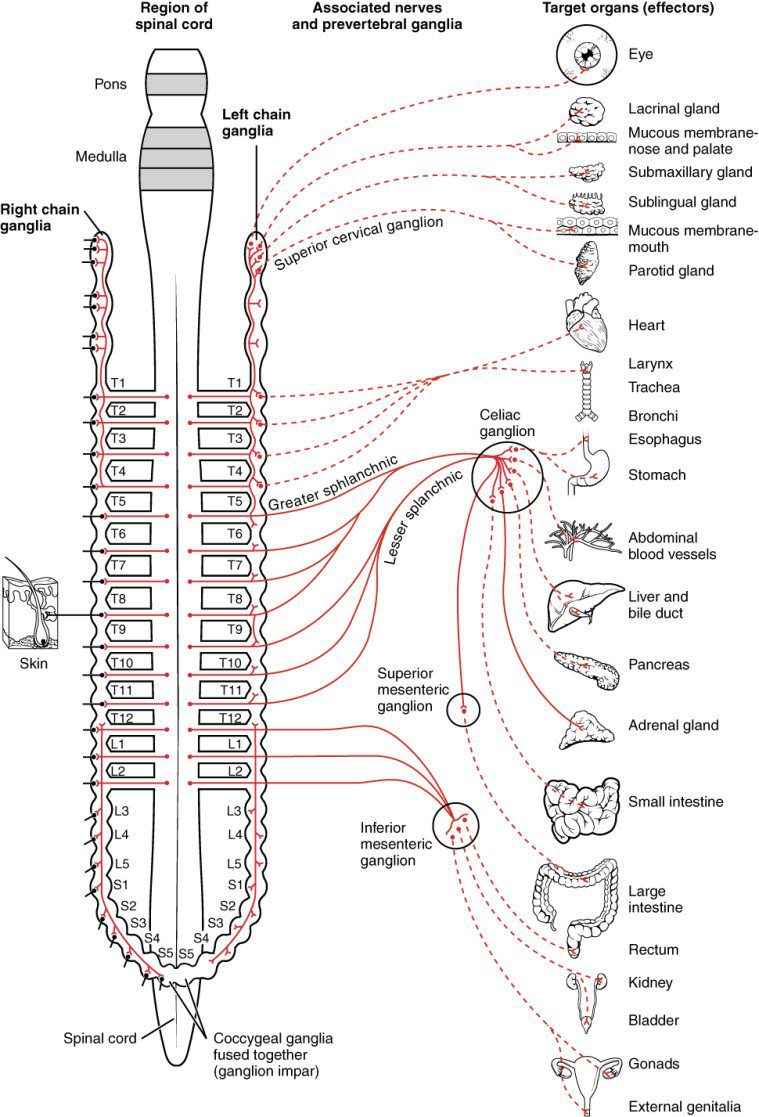
If one takes a look at the image above, one can see how the nerves from the spinal cord connect to specific areas of the body. A chiropractor or acupuncturist will be able to spot spinal problems and fix them over time. This is what they are trained to do.
Here Are Some Tips To Take Care Of The Spine From Spine Health:
- Sitting correctly or using an ergonomic chair while at work is a good way to take care of the spine.
- Exercise abs and back daily to strengthen the muscles around the spine and keep it in place.
- Take time to get a massage, see a chiropractor, or an acupuncturist. This will help the spine stay in the correct shape.
- Wear shoes that support the feet and feel comfortable. Uncomfortable shoes, especially pumps, will injure the back and spine.
- Sleep with the spine in mind. Choose a mattress and pillow that supports the spine and try to sleep in a natural position. Also, try sleeping on your arm to get a nice straight spine when lying on your side rather than using a pillow that can tilt your head up and kink your neck.
If one is suffering back pain, it is important to seek professional help. Spine problems, like a pinched nerve, if not taken care of, can become extremely severe. The spinal cord controls the body. In order to be in the best of health, the spine needs to be in good health.
Take care of�your spine and it will take care of you all the years of your life.

Call Today!
Source: David Wolfe

by Dr Alex Jimenez DC, APRN, FNP-BC, CFMP, IFMCP | Chiropractic, Chronic Back Pain, Migraines, Neck Pain
El Paso TX. Chiropractor, Dr. Alex Jimenez discusses ways�to assist you to get the care you’ll need at your next appointment.
Dr. Michael J. Cooney, D.C�I�ve been treating patients with severe and chronic pain from around the corner in Rutherford, New Jersey to as far away as Australia and South Africa.
From our patient�s first reference to the past treatment office visit, the success of any pain treatment we prescribe is contingent upon us (the health care provider) correctly treating the root cause of your pain.
As the patient, just describing your intense pain or neuropathic pain is a high stakes� conversation that is �. I am able to read your medical history, attributing lab results and physician reports, however this really is secondary to understanding each patient�s pain mechanics. It is absolutely vital this is communicated to your pain management provider as correctly as possible.
For those fighting �invisible pain” such as fibromyalgia, CRPS (complex areas pain syndrome), RSD (reflex sympathetic dystrophy), diabetic neuropathy or long-term pain after cancer treatment, correctly communicating the place, frequency and depth of the discomfort can be especially demanding and emotionally taxing.
You might wish to bring this short article for your next doctor visit and go over each of the key pain description points I�ve outlined below.
I really hope your doctor will ask you these questions, but if not, you are able to behave as your own pain promoter and offer this information.
�Tell Me About Your Pain�
Based upon your medical records, we already know the reason behind your pain (injury or ailment). In order to restart your highest quality of life possible, our goal would be to remove or minimize this symptom.
Pain symptoms are private, subjective –and unique. (What Joe describes as �unbearable pain� could be considered �fairly disagreeable pain� to Mike). Through the years, I developed my own �pain diagnostic� conversation with patients to assist my team and I understand what, where, when and just how much pain patients are feeling.
I�ve outlined key points below:
Time Matters
This is key to a proper analysis. Don�t presume we know you�ve combated with this pain to get a month a year or a decade.
1.I�ve had this pain for _________________.
2.How frequently and how long does it last?
3.What ignites (flare) or lessens your pain and for how long?
Location, Location, Location
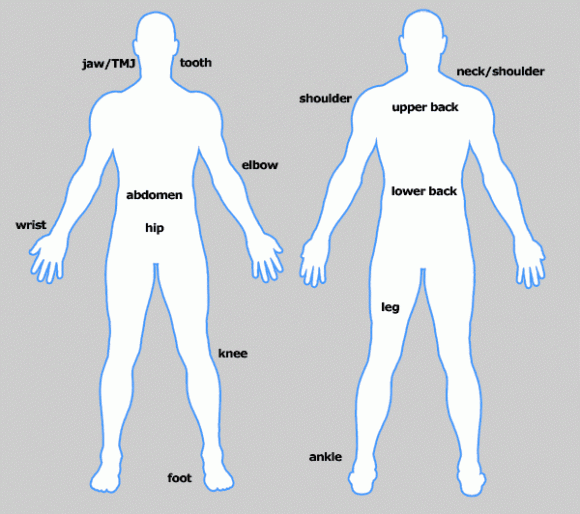
Graphic of a human body with a rear & front view (see above)
Doctors may instruct you to indicate the area/s where your pain is concentrated. They may also request that you notice a difference between pain which is on pain and the surface that’s below the surface.
The front and back of the unisex individual figure are the most identifiable, although this tool comes from the McGill Pain Questionnaire including other measurements.
Most referring physicians, regardless of their medical specialty, utilize 1 to 10 point pain scale that is simple, so�I keep everyone on the same page.
This tool comes from the McGill Pain Questionnaire including other measurements, but the front and back of the unisex person body are the most identifiable.
How Bad Is Your Pain – Measurement Tool

Simply said, take into consideration where your pain level falls the majority of the time�unless you experience extreme pain changes.
No Pain
0 � Painfree
Manageable Pain
1 � Pain is quite mild, barely noticeable. You don’t think about it.
2 � Small pain. Annoying and may have occasional twinges that are stronger.
3 � Pain distracting and is noticeable, you may get used to it and adapt.
Moderate�Pain�Disrupts Regular Day-To-Day Living Tasks
4 � Moderate pain. If you should be deeply in an action, it may be blown off to get a time frame, but is diverting.
5 � Moderately strong pain. It can’t be dismissed for more than a few minutes, but you still can manage to work or participate in some social activities.
6 � Rather strong pain that interferes with normal daily activities. Difficulty focusing.
Severe�Pain�Disabling; Debilitating, Reduces Daily Quality Of Life, Cannot Live Independently
7� Severe pain that dominates your senses and significantly restricts your capability to perform ordinary daily tasks or maintain social relationships. Interferes with sleep.
8� Intense pain. Physical action is seriously limited. Conversing requires great exertion.
9. Not able to converse. Weeping outside or moaning uncontrollably.
10� Unspeakable pain. Perhaps and bedridden delirious. Mobility may be undermined.
�My Pain Feels Like��
Most of the time, patients experience one or two consistent pain �feelings� but some can experience a variety of sensations.
The most common pain kinds are:
- Sharp stabbing pain
- Extreme heat or burning sensation
- Extreme cold
- Throbbing, inflamed tissue
- Susceptibility to contact / touching
- Itching
- Numbness, tingling, pins & needles
Create A Pain Journal

I motivate patients or their family members to document a weeklong pain cycle till they meet with chiropractic, their pain management or alternative medicine team.
Additionally, jot down any treatments or activities�that lessen or increase your discomfort.
As an example, maybe you have discovered that hot showers or cold weather allows you to feel worse, but exercise or Epsom salt baths makes the pain more manageable.
If you come prepared with all this information, your time with all the physician can be spent focusing on next steps and also a treatment plan, rather than a lengthy Q & A review of the information supplied here.
More importantly, addressing these issues beforehand will ensure your physician receives up-to-date, higher quality information.
Consequently, your case could be assessed more quickly and a pain management plan can be placed into action to begin removing or reducing your suffering as rapidly and efficiently as possible.

Call Today!

by Dr Alex Jimenez DC, APRN, FNP-BC, CFMP, IFMCP | Chiropractic, Chronic Back Pain, Migraines, Neck Pain
About Pain Management (Medicine) Specialists
A pain medicine specialist is a medical or osteopathic doctor who treats pain due to disease, ailment, or injury. Many of these doctors are physiatrists or anesthesiologists although called interventional pain management specialists or pain medicine. Pain medicine is a mutlidisciplinary team effort generally affecting specialists in other disciplines, complimentary alternative medicine, along with radiology, psychiatry, psychology, oncology, nursing, physical therapy, and the patient’s primary care physician or other treating doctor.

Education & Training
After graduating medical school and completing a one-year internship, the physician enters a residency program normally in physical or anesthesiology medicine but sometimes from other fields like psychiatry and neurology. Upon conclusion of a residency program (typically 3 years long), the physician completes a one-year fellowship for advanced training in pain medicine.
Many pain medicine specialists are board certified. The organizations that board certify physiatrists, anesthesiologists, neurologists, and psychiatrists all collaborate to provide the board examination for the subspecialty of Pain Medicine. You can find numerous opportunities for pain management specialists to remain current with medical and technical improvements in pain medicine, such as scientific journals and society meetings.
Targets of Pain Management
The goal of pain medicine is to handle severe or long-term pain by reducing intensity and pain frequency. Besides addressing pain problems, a multidisciplinary pain management program may address your functional goals for activities of day-to-day living. Overall, a pain medicine plan aims to give you a feeling of well-being, increase your level of action (including return to work), and reduce or eliminate your reliance on drugs.
Many Kinds of Pain Treated
Pain medicine specialists treat all sorts of pain. Severe pain is described sharp or as acute and may indicate something is wrong. The pain experienced during dental work is an instance of intense pain. Pain lasting 6 months or longer is defined as chronic. This type of pain varies from mild to serious and is consistent. Spinal arthritis (spondylosis) pain is frequently chronic. A good consequence is produced by uniting different treatments regularly although chronic pain is difficult to handle.
- Degenerative disc disease
- Facet joint pain
- Sciatica
- Cervical and lumbar spinal stenosis
- Spondylolisthesis
- Whiplash
What to Anticipate During an Appointment
Your appointment with a pain or interventional pain management practitioner is much like other doctor visits. Although there are many similarities, the focus is fast managing it, and on your pain, the cause or contributing factors.
Pain medicine physicians execute a physical and neurological examination, and review your medical history paying particular focus on pain history. You may be asked many questions about your pain
- On a scale from zero to 10, with 10 being the worse pain imaginable, speed your pain.
- When did pain start? When pain started, what were you doing?
- Does pain disperse into other regions of the body?
- Is its intensity persistent, or is it worse at different times of night or the day?
- What really helps to alleviate the pain? Why is pain worse?
- What treatments have you ever attempted? What worked? What failed?
- Would you take over the counter drugs, vitamins, or herbal nutritional supplements?
- Does one take prescription medication? If so, what, how much, and how frequently?
Most pain medicine specialists utilize a standardized drawing of the front/back of the body to let you mark where pain is sensed, as well as indicate pain spread and type (eg, light, sharp). You may be asked to complete the form each time you see with the pain physician. The finished drawing helps you to evaluate your treatment progress.
Accurate Analysis Key to Treatment
Pain medicine includes diagnosing origin or the cause of pain. Making the proper identification may include getting an X ray, CT scan, or MRI study to verify the reason for your neck pr back pain. When treating spine-associated pain (which may include arm or leg symptoms), other tests, like discography, bone scans, nerve studies (electromyography, nerve conduction study), and myelography could possibly be performed. The proper analysis is crucial to some favorable treatment plan.
Some spinal ailments and pain treatment requires involvement of other specialists, such as your primary care physician, neurosurgeon, orthopaedic surgeon, and practitioners in radiology, psychiatry, psychology, oncology, nursing, physical therapy, and complimentary alternative medicine. The pain medicine specialist may consult with and/or refer you to a neurosurgeon or orthopaedic spine surgeon to determine if your pain difficulty necessitates back operation.

Call Today!
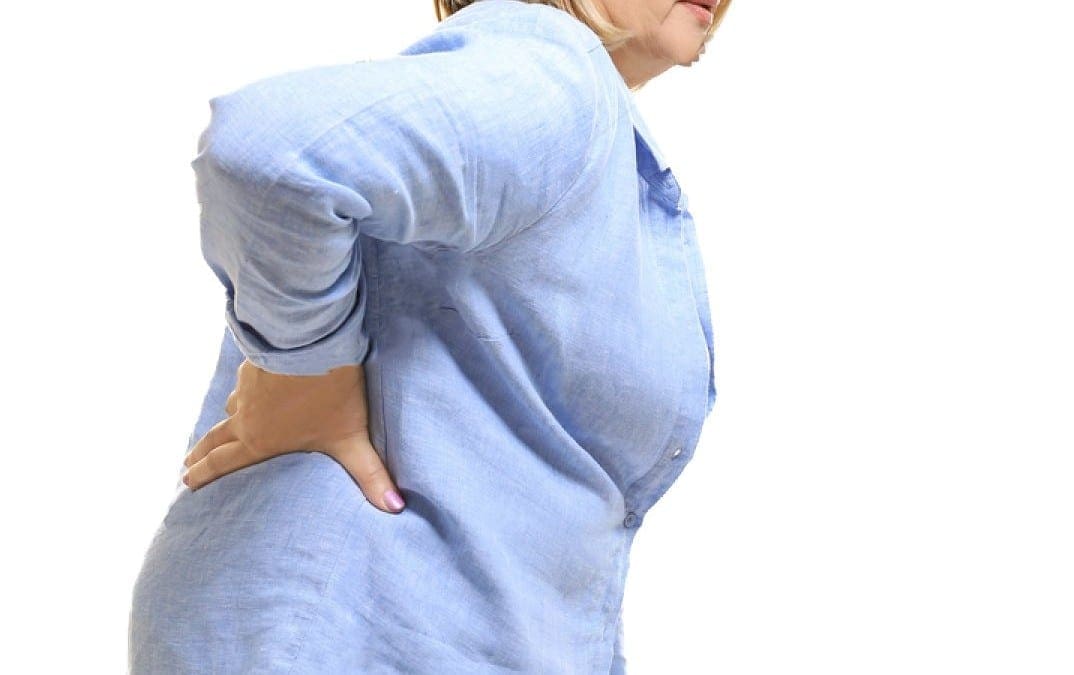
by Dr Alex Jimenez DC, APRN, FNP-BC, CFMP, IFMCP | Chiropractic, Chronic Back Pain, Migraines, Neck Pain
You get up with it. You go to sleep with it. An incredible number of men and women live with chronic back or neck pain every day. What’s chronic pain? It is technically defined as pain that lasts for 12 weeks or more�even after pain isn’t any longer acute (short-term, serious pain) or the injury has healed.
Accurate Analysis
Getting an exact identification of the reason for neck pain or your back is vital to the outcome of your treatment plan. Depending on the severity and cause of your pain that is chronic, you might need to find out different specialists in addition to your own primary care physician�pain medicine specialist, orthopaedic spine surgeon, neurosurgeon, physiatrist, rheumatologist, physical therapist among others. Over time your chronic pain need to be reevaluated, and may transform, which might affect the way it is handled.
Your chronic back or neck pain treatment generally features a variety of treatments to maximize results that are great. A number of the treatments your doctor prescribes and recommends may include:
Physical Therapy:
Extending and strengthening muscles is vital in the treatment of neck pain or chronic back.
Chiropractic Care:
Depending on your own diagnosis, chiropractic care may be recommended by your doctor. Studies have demonstrated that two weeks of day-to-day exploitation by a chiropractor can result in considerable progress in a few patients with persistent low back pain and referred leg pain.

Medicines:
There are lots of different prescription medications to take care of neuropathic pain, inflammation, muscle spasms, and pain. Additionally, you will find drugs to treat conditions that often accompany chronic pain, including drugs that will help you sleep, alleviate depression, and reduce nervousness.
Processes:
Your doctor may recommend a spinal cord stimulator, spinal injections, drug heart, or spine surgery. You can get a second opinion, in the event you might be uncertain about the treatment plan recommended.
Coping skills:
Never underestimate the power of your head. Your mood and mental perspective can greatly make an impact on your level of pain. Talk with a trained specialist to understand relaxation and coping skills.
Complementary Treatments:
Many physicians recommend acupuncture and other types of traditional Chinese medicine. Speak to your doctor about these choices.
A couple of words about …. age, fitness, body weight
You probably involve some control over body weight and your level of fitness, although you can�t stop aging or its effects. While you can�t stop the clock on the cellular changes that are recognized to accompany aging�such as loss of muscle mass and bone density �you can take little steps today to build a more stronger�you tomorrow.
It�s understood that patients with chronic back or neck pain may not feel like being active, going to the gym and even adhering to a home exercise program. Yet, being active can help chronic pain because during exercise your body releases endorphins�your body�s natural painkiller.
Moreover, by teaming up together with and/or your physician physical therapist you can start to build abdominal muscles that are strong �essential to your own body�s center strength which helps support your back.
Did you know that by simply losing even 5 to 10 pounds you can reduce back pain? It�s true. Carrying around extra weight translates to added stress to the low back that may exacerbate pain.
Conclusion
In many instances, aggressive and early treatment of chronic back or neck pain can make a life-changing difference. But remember that knowledge is power: Be certain you comprehend your alternatives before deciding which route to take.

Call Today!

by Dr Alex Jimenez DC, APRN, FNP-BC, CFMP, IFMCP | Chiropractic, Lower Back Pain, Migraines, Neck Pain
Although their main method of treatment is the spinal manipulation, many chiropractors also use other therapies to treat their patients. The following is a brief description of some of the most common therapies chiropractors offer.
Therapeutic Exercise
Chiropractors commonly prescribe specific strengthening exercises for their patients with back, neck, and extremity problems. These exercises can decrease pain, prevent muscle deterioration, promote joint health, increase strength, stability and range of motion, and protect against new or recurring injuries.
Your chiropractor will show you how to do the exercises and supervise you until you are comfortable doing them on your own. It’s important to keep up with your exercises as prescribed (similarly to drug prescriptions). Studies show that individuals who follow their exercise instructions heal faster than those who do not.
Therapeutic Stretches
Following an injury, therapeutic stretching is an important way to prevent scar tissue from forming. Even after the injury has healed, maintaining a regular stretching program helps keep tissues flexible, increases mobility, and protects you from new injuries. As with exercise, your chiropractor will instruct you on proper stretching techniques and will supervise you until you are comfortable enough to do them on your own.
Traction
Many chiropractors use traction, in which traction devices are applied to distract areas of the spine. This treatment helps separate the vertebrae resulting in disc decompression, reduced nerve root pressure, and decreased.
Soft Tissue Manual Therapy
Chiropractors use a variety of hands-on soft tissue therapies to improve the function of the soft tissues (muscles, ligaments, tendons, and joint capsules).�These include pin and stretch, also known under a proprietary name Active Release Technique (ART) and instrument-assisted soft tissue mobilization (Graston Technique).
Physical Therapy Modalities
Muscle Stimulation
This type of therapy uses light electrical pulses that are transmitted to specific areas of the body through electrodes placed on the skin. There are many different types of electrical stimulation. Some are more beneficial for pain relief or to reduce inflammation, some best treat muscle spasm, and some actually cause muscles to contract in order to reduce muscle atrophy. Some forms of electrical stimulation have combination effects.
TENS
A TENS (transcutaneous electric nerve stimulation) unit is a small, battery-powered, portable muscle stimulation machine that can be used at home to help control pain. Variable intensities of electric current are used to control pain. This treatment is recommended to help patients get through periods of severe (acute) pain. TENS units are typically not recommended for chronic pain. In fact, a 2009 �report from the American Academy of Neurology found that TENS units are not effective at treating chronic low back pain.1
Ultrasound
Therapeutic ultrasound is a form of deep heat therapy created by sound waves. When applied to soft tissues and joints, the sound waves are a form of micro-massage that help reduce swelling, increase blood flow, and decrease pain, stiffness, and spasms.
Ice and Heat Therapy
Ice and heat have long been used to treat many painful conditions. Ice therapy is often used to reduce swelling and help control pain immediately after an injury. Heat therapy is used to relax the muscles, increase circulation, and can provide relief to patients with chronic pain. Depending on the patient’s condition, a combination of ice and heat can be used.
Diet and Nutritional Counseling
Studies have shown that poor diet and nutritional imbalances contribute to a number of serious illnesses, such as heart disease, stroke, diabetes, and cancer. Chiropractors are specifically trained in diet and nutritional counseling. Your chiropractor can design a nutritional program specific to your needs that can help you maintain good health and minimize the risk of developing these serious health conditions.
Lifestyle Modification Counseling
Good health is much more than the absence of pain or disease. The lifestyle choices you make on a daily basis can greatly affect your long-term health. We now know that years of seemingly small unhealthy lifestyle choices can, over time, turn into very large health problems. Examples of lifestyle choices and behaviors that can have negative effects on your health include:
- lack of regular exercise
- smoking
- poor diet
- excessive mental stress
- over-reliance on medication
- excessive consumption of alcohol
- poor posture
- improper lifting
Your chiropractor will talk to you about your lifestyle choices, help you sort through and identify unhealthy health habits, and give you practical strategies to deal with and manage them.
As you can see, chiropractic medicine is more than just spinal manipulations. Chiropractors use a variety of treatment modalities to help the body to heal itself and return the patient to a pain-free and healthy life.

Call Today!

by Dr Alex Jimenez DC, APRN, FNP-BC, CFMP, IFMCP | Chiropractic, Chronic Back Pain, Migraines, Neck Pain
Many of us experience back and neck pain. But when is it the right time to see a chiropractor for a diagnosis or treatment? And can they really help? The answer is yes.
Chiropractors have been around for a hundred years, and are licensed doctors who are required to pass a series of four national board exams and are regulated by state licensing boards. They are medical professionals who diagnose and treat musculoskeletal and nervous system disorders.
A chiropractor can use many different techniques to relieve pain, including applied pressure, massage, and hands-on manipulation (adjustment) of the vertebrae and joints. They may also order X-rays, MRI studies, and lab work. Chiropractors don�t prescribe medications, but they do recommend such things as therapeutic and rehabilitative exercises and nutritional and lifestyle counseling to help the body heal itself.

Chiropractors believe one of the main causes of back or neck pain is subluxation. Subluxation occurs when your vertebrae become misaligned. Treating subluxations can help to alleviate pain associated with a myriad of conditions, including:
- headaches
- sciatica
- trauma, such as whiplash
- scoliosis
- leg pain
- sports injuries
- bursitis and tendonitis
- fibromyalgia
- spinal arthritis (spondylosis)
Sometimes chiropractic care (eg, an adjustment) can cause mild soreness or aching but that usually resolves itself within 12 to 48 hours.
Chiropractic Tests
When you visit your chiropractor for the first time, he/she will probably ask you to perform a series of simple tests to evaluate your posture and range of motion. You may be asked to bend forward,� backward or side-to-side. The chiropractor will also check the way you walk and how your posture looks sitting down and standing up.� Other tests may include:
- Piriformis Test: The patient flexes and bends the knee while lying down.
- Straight Leg Raise: One leg at a time is raised in a locked-knee position to check the sciatic nerve and flexibility of the hamstring muscle.
- Measuring the length of each leg helps determine if there is a discrepancy in leg length or if the pelvis is out of balance.
- Hand strength (grip)
- Evaluation of reflexes and muscle testing
Sometimes you might hear a pop while the chiropractor is testing or adjusting you, which is perfectly normal. This is caused by small pockets of air or bubbles in the fluid that surrounds your joints. When joint tissues are stretched, those pockets of air �pop,� which creates the cracking sound you hear.
Diagnosis
Once the chiropractor identifies the problem, he/she can recommend treatment options, and explain how many chiropractic visits are necessary to reach an expected outcome (eg, resolution of pain). He/she may also suggest improvements to your diet and lifestyle, such as quitting smoking or increasing/modifying certain activities. A chiropractor may also recommend certain types of exercises in conjunction with chiropractic treatment to stretch and/or strengthen the back and neck.
Adjustment Techniques
A chiropractor is educated in dozens of ways to treat pain. Here is a sampling of the different techniques that may be used.
Toggle Drop � The chiropractor presses down firmly on a particular area of the spine followed by a quick and precise thrust.
Lumbar Roll � With the patient on his/her side, a quick thrust is applied to the misaligned vertebrae.
Release Work � The chiropractor uses gentle pressure with the fingertips to separate the vertebrae.
TENS (Transcutaneous electrical stimulation) � This device sends stimulating pulses across the surface of the skin and nerve strands to block pain signals along the nerves and release endorphins which are natural painkillers.
Cold/Heat Treatment � Chiropractors may alternate between ice and heat therapy to treat back or neck pain. Ice packs are used to reduce inflammation (swelling) for 15 minutes at a time. A heating pad (or other heat source) helps increase circulation and may promote faster healing.
Table Adjustments � The patient lies on a special table with a �drop piece� then a quick thrust is applied when the table drops.
Instrument Adjustments � Instead of hands-on manipulation, the patient lies on the table face down while the chiropractor uses a spring-loaded activator instrument to perform the adjustment.
Manipulation Under Anesthesia � This is performed by chiropractors certified in this technique. The treatment is performed in a hospital outpatient setting.
Keep in mind that chiropractic care is not a cure-all for your back and neck pain! However, it is considered by many to be a safe and effective way to help relieve pain and improve spinal function. Many physicians and surgeons recommend chiropractic care to their patients.

Call Today!
Written by Stewart G. Eidelson, MD



























